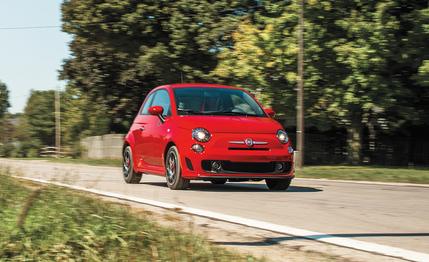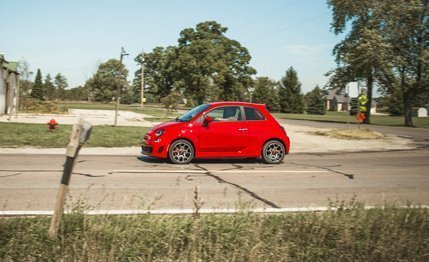
 Instrumented Test
Instrumented Test




Last year, Aston Martin looked at its $194,000 DB9 and $281,000 DBS and decided it was neglecting a customer—it may have been only one—in between. Along came the $212,000 Virage, with 50 percent of the DBS’s extra power for 21 percent of its premium. Fiat finds itself in a similar predicament with the white space between its $16,700 entry-level 500—autodom’s Most Likely to Be Painted Pink even before you consider the 101 horsepower—and the snarly 500 Abarth, $22,700 with 160 horses. Lacking a bank of French words previously trademarked as car names, Fiat calls its Virage the 500 Turbo.
At $20,200, the 135-hp 500 Turbo tends toward the Abarth end of the scale in output, price, and appearance. Its nose will fool people into thinking you’ve got Abarth money (seven-star hotels, fractional jet ownership...), as it wears the more-potent car’s fascia, although out back you only get one exhaust outlet instead of the Abarth’s two. Also from the Abarth, the 500 Turbo borrows its engine (detuned), manual transmission, final-drive gearing, half-shafts, CV joints, brakes, and lower control arms. Stuff carried over from the 500 Sport—slightly firmer than the Pop and Lounge trims—includes the torsion-beam rear suspension, spring rates, shock tuning, and electrically assisted power-steering calibration. Laudably, the five-speed manual is the only choice in either car. The Abarth refused to share its Koni shocks, unique rear suspension, and stiffer, shorter springs.


Whereas Aston immediately realized it was slicing its market too thin—the DB9 is now essentially the Virage, and the Virage has disappeared—the approach makes more sense for Fiat. We don’t miss the Abarth’s firmer setup, optimized for driving on glass coffee tables. Over rough pavement, the 500’s short wheelbase makes for a choppy ride no matter the spring rates, but the Turbo’s suspension reduces head-banging compared with the Abarth. Agile and with wonderfully quick, linear steering, the Turbo—like all 500s—is cursed by its high seating position and tippy feeling. Occupants sit so high off the floor that they feel like they’ve entered a bar-stool race. We get the impression that the driver’s weight impacts the center-of-gravity height more in the 500 than in anything else with four wheels.


At 8.1 seconds to 60 mph, the Turbo’s straight-line performance is closer to the Abarth’s 6.9 than the base 500’s 9.9. It’s still not quick, but it’ll at least keep pace with a leadfoot in a Mini Cooper. We do miss the Abarth’s exhaust note, an angry rip that firmly establishes it as something other than an internal-combustion teacup poodle. Without the Abarth’s bristle, the Turbo is deeply ingrained with cuteness. Its pedals are superlight, as if weighted for feet accustomed to ballet slippers, and the clutch-return spring feels as though it’s fashioned from a few golden curls snipped from the head of a napping child. Quicker, yes, but hardly manlier.
Then again, Fiat doesn’t call this the Abarth Lite. It’s a 500 Turbo, which describes exactly what it feels like: a 500 with more power. No identity crisis here. But perhaps there’s a financial crisis. At $16,700, the base 500 can be forgiven many faults. At $20,200 (that’s $103 for each additional horsepower), the Turbo is priced against a lot of grown-up cars. The $2500-more-expensive Abarth is a fun little thing. The Turbo is just a not-slow little thing.